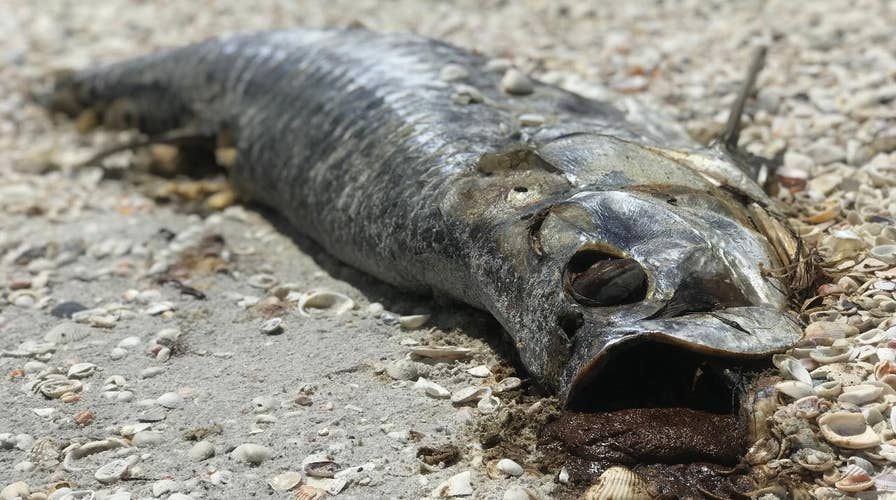Red Tide killing sea life, causing sickness along Gulf Coast
The Sunshine State’s southwest coast has been ravaged by an unrelenting Red Tide this summer—thousands of dead fish have clogged waterways, while manatees, sea turtles and even a whale shark have washed ashore after falling victim to the dangerous water conditions.
LITTLE GASPARILLA ISLAND, Fla. – Albert Fernandez has been fishing the waters of Florida his entire life. But the once crystal-clear water he remembers has turned a brownish-red the past few months because of a toxic algae polluting the water.
“I haven’t been here in months and reason being is because I’m not going to enjoy myself,” he said while tying his aptly named boat, The Aquaholic, to a dock near his home on Little Gasparilla Island, a barrier island about an hour south of Venice, Fla. The island is only accessible by boat and commutable by golf cart, luring visitors from around the world in search of remote tranquility.
The area is normally brimming with wildlife. But recently, the state’s Gulf Coast has been ravaged by an unrelenting Red Tide—thousands of dead fish have clogged waterways, while manatees, sea turtles and even a whale shark have washed ashore after falling victim to the dangerous water conditions.
The bloom occurs when “colonies of algae—simple plants that live in the sea and freshwater — grow out of control while producing toxic or harmful effects on people, fish, shellfish, marine mammals, and birds,” according to the National Ocean Service.
When marine life ingests the toxins, they become disoriented and drown. Their decaying bodies then have the potential to kill off whole marine ecosystems because decomposition can deplete oxygen in the water, killing other animals in the area or forcing them to move elsewhere.
Humans are at risk, too, in some cases. Red Tide can be deadly for those with asthma or other respiratory problems.
“Folks that have lived here 20, 30, 40 years, they’re actually considering selling their homes because of this,” Fernandez said. “It’s affecting them physically. They’re getting sick.”

"It's awful, as soon as I got out of my car which is several hundred feet away it hit the back of my throat," said Sarasota resident Erin Alonso. "It makes you cough, it's just terrible." (Fox News)
The Sunshine State is no stranger to the natural phenomenon. The blooms show up on the coast almost every year. But this is different—and far more severe.
“I’ve been through some pretty bad ones, we’ve lived here for 30 years,” said Laurie Gaines, a rental property manager on the island. “There was a particularly bad one in 2006…but this one just doesn’t seem to go away.”
“It’s going to get worse before it gets better,” said Robert Weisberg, University of South Florida professor of physical oceanography, “we are still seeing the vestiges of the Red Tide from last year, which never fully went away and the conditions offshore this year have been conducive to form a new bloom, which will make its way to the shoreline soon.”
All along the coastline, vacation destinations have turned into ghost towns, angering residents of a state highly dependent on tourism.
“For a place where 70 percent of our seating is outside, this has been pretty devastating,” said Joe Farrell, owner of Pop’s Sunset Grill in Nokomis, Fla. “All the businesses are being affected by it.”
“As a rental manager, I’m telling people ‘we’ll allow you to reschedule and give you refunds,’” said Gaines. “We can’t encourage people to come to the island in situations like this, knowing their family vacations will be ruined.”
Red Tide blooms manifest along the shoreline in the late summer and fall seasons and typically last a few months. Weisberg said they originate 40 to 50 miles offshore and move with the current to the shoreline in some cases, but they travel underwater and are not detectable until they reach land.
Weisberg said a “perfect storm” of water current, warmth, bacteria and nutrients come together to form algae blooms, but other contributing factors are the result of humans, such as water contamination by fertilizers, sewage and septic tank runoff.
The blooms have spread as the U.S. Army Corps of Engineers releases water from Lake Okeechobee to keep levels down to protect the aging Herbert Hoover Dike. Hurricane Irma only worsened the situation when it plowed over the state, churning the lake’s nutrient-rich bottom as it traveled across the ocean-like body of water with tropical force winds. Much of that water was released in the weeks after the storm through the Caloosahatchee and St. Lucie Rivers and is thought to be a major factor in this year’s outbreak.
“This is something that’s affecting not only the economy, but the ecology, which is so sensitive down here in Florida,” Fernandez said.
Florida Gov. Rick Scott, a Republican, issued an executive order last month, declaring states of emergency in several counties to help combat the growing blooms and announced an agreement on a $50 million state investment to fund repairs to the dike. The agreement follows a $50 million investment made earlier this year, bringing the state's total investment in the federal project to $100 million to reduce the amount of harmful water runoffs by allowing more water to be stored in the lake.
“As our communities once again face the threat of harmful algal blooms caused by water releases from Lake Okeechobee, we are continuing to find innovative ways to combat this serious problem and fix the federal government’s years of inaction," Scott said in the release.

This year's Red Tide has turned Florida's most popular beaches into deserted wastelands. (Fox News)
It’s unclear how long the Red Tide will last.
“People are not seeing the beach at its best, they’re not seeing Florida at its best,” Gaines said, “and it’s a shame.”

